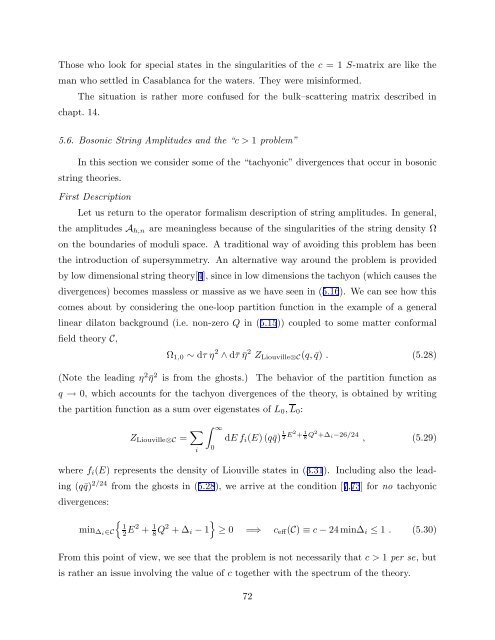arXiv:hep-th/9304011 v1 Apr 5 1993
arXiv:hep-th/9304011 v1 Apr 5 1993
arXiv:hep-th/9304011 v1 Apr 5 1993
You also want an ePaper? Increase the reach of your titles
YUMPU automatically turns print PDFs into web optimized ePapers that Google loves.
Those who look for special states in <strong>th</strong>e singularities of <strong>th</strong>e c = 1 S-matrix are like <strong>th</strong>e<br />
man who settled in Casablanca for <strong>th</strong>e waters. They were misinformed.<br />
The situation is ra<strong>th</strong>er more confused for <strong>th</strong>e bulk–scattering matrix described in<br />
chapt. 14.<br />
5.6. Bosonic String Amplitudes and <strong>th</strong>e “c > 1 problem”<br />
In <strong>th</strong>is section we consider some of <strong>th</strong>e “tachyonic” divergences <strong>th</strong>at occur in bosonic<br />
string <strong>th</strong>eories.<br />
First Description<br />
Let us return to <strong>th</strong>e operator formalism description of string amplitudes. In general,<br />
<strong>th</strong>e amplitudes A h,n are meaningless because of <strong>th</strong>e singularities of <strong>th</strong>e string density Ω<br />
on <strong>th</strong>e boundaries of moduli space. A traditional way of avoiding <strong>th</strong>is problem has been<br />
<strong>th</strong>e introduction of supersymmetry. An alternative way around <strong>th</strong>e problem is provided<br />
by low dimensional string <strong>th</strong>eory[4], since in low dimensions <strong>th</strong>e tachyon (which causes <strong>th</strong>e<br />
divergences) becomes massless or massive as we have seen in (5.16). We can see how <strong>th</strong>is<br />
comes about by considering <strong>th</strong>e one-loop partition function in <strong>th</strong>e example of a general<br />
linear dilaton background (i.e. non-zero Q in (5.15)) coupled to some matter conformal<br />
field <strong>th</strong>eory C,<br />
Ω 1,0 ∼ dτ η 2 ∧ d¯τ ¯η 2 Z Liouville⊗C (q, ¯q) . (5.28)<br />
(Note <strong>th</strong>e leading η 2¯η 2 is from <strong>th</strong>e ghosts.) The behavior of <strong>th</strong>e partition function as<br />
q → 0, which accounts for <strong>th</strong>e tachyon divergences of <strong>th</strong>e <strong>th</strong>eory, is obtained by writing<br />
<strong>th</strong>e partition function as a sum over eigenstates of L 0 , L 0 :<br />
Z Liouville⊗C = ∑ i<br />
∫ ∞<br />
0<br />
dE f i (E) (q¯q) 1 2 E2 + 1 8 Q2 +∆ i −26/24 , (5.29)<br />
where f i (E) represents <strong>th</strong>e density of Liouville states in (3.31). Including also <strong>th</strong>e leading<br />
(q¯q) 2/24 from <strong>th</strong>e ghosts in (5.28), we arrive at <strong>th</strong>e condition [7,73] for no tachyonic<br />
divergences:<br />
min ∆i ∈C<br />
{<br />
}<br />
1<br />
2 E2 + 1 8 Q2 + ∆ i − 1 ≥ 0 =⇒ c eff (C) ≡ c − 24 min∆ i ≤ 1 . (5.30)<br />
From <strong>th</strong>is point of view, we see <strong>th</strong>at <strong>th</strong>e problem is not necessarily <strong>th</strong>at c > 1 per se, but<br />
is ra<strong>th</strong>er an issue involving <strong>th</strong>e value of c toge<strong>th</strong>er wi<strong>th</strong> <strong>th</strong>e spectrum of <strong>th</strong>e <strong>th</strong>eory.<br />
72
















